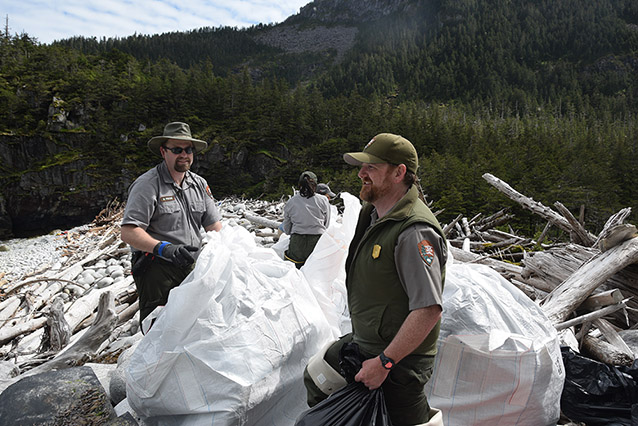
NPS Photo
Remote coastal beaches in Alaska wilderness surrounded by high, scenic mountains or vast coastal plains are often the last places that visitors expect to find man-made materials and trash. However, many of these remote beaches receive significant accumulations of marine debris due to ocean currents, vessel traffic, and storm surges (Howell et al. 2012).
For example, the deadly March 2011 Tōhoku earthquake resulted in a tsunami in Japan that generated approximately 1.5 million tons of floating debris. This detritus was transported across the North Pacific on ocean currents (Government of Japan 2012; NOAA 2013) and has been found on the west coast of North America, including Alaska (NOAA 2013). The arrival of the tsunami rubble brought immediate attention to the persistent marine debris issue in Alaska and across the United States. For the Northwest Arctic, marine debris concerns are also heightened by the decreasing extent of sea ice, which allows for more vessel traffic and increases the open-water period for debris to move into and throughout Arctic waters (Arctic Council 2009).
Under the 2006 Marine Debris Research, Prevention, and Reduction Act, marine debris is officially defined as “any persistent solid material that is manufactured or processed and directly or indirectly, intentionally or unintentionally, disposed of or abandoned into the marine environment” (33 USC 1951 et seq. as amended by Title VI of Public Law 112-213). Marine debris includes fishing gear, plastic materials, building materials, and any other non-natural, solid materials that come onshore. These types of debris can affect marine mammals and birds directly through entanglement, strangulation, and digestive blockage (reviewed by Derraik 2002, U.S. Environmental Protection Agency 2011, Ryan et al. 2009). Marine debris can transport invasive marine organisms, which have the potential of causing ecological and economic impacts. In addition, marine debris is unsightly and can be a negative effect for visitor experience.
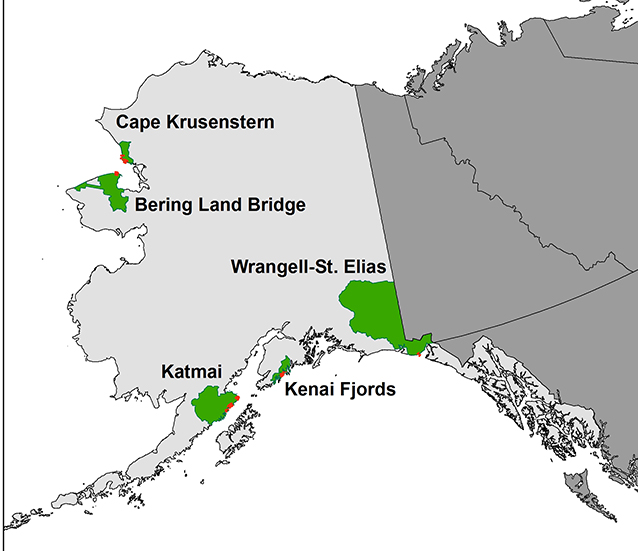
Plastics break down over time into microplastic particles that can more readily enter the food web and persist. Research has shown that bioaccumulative toxic substances adsorbed from the ocean by experimentally provided microplastics were readily transferred to fish in cages in the Pacific Ocean (Rochman et al. 2013), with the implication that large volumes of microplastics in the ocean are a mechanism for transferring toxic substances into the food web. For rural Alaska communities dependent on marine mammal subsistence harvest, the potential for bioaccumulation of toxic substances is of particular concern. To compound the potential, it has also recently been discovered that Arctic sea ice in remote locations contains concentrations of microplastics several orders of magnitude higher than those previously reported in highly contaminated surface waters such as those of the Pacific Gyre (Obbard et al. 2014).
In summer 2015, we conducted an extensive five-park, multi-partner project to remove marine debris from park beaches known to have high to moderate levels of marine debris accumulation. The five park units were Bering Land Bridge National Preserve, Cape Krusenstern National Monument, Katmai National Park, Kenai Fjords National Park, and Wrangell-St. Elias National Park and Preserve. Beaches in these parks are not accessible by roads, which made debris removals logistically challenging and costly, but with numerous partners and good weather, we managed to successfully remove over 11 tons of marine debris from these remote beaches.
Methods and Findings
Marine debris was collected from 28 beaches in five National Park Service units between May 21 and July 22, 2015 (Figure 2). Beaches in each park were not randomly chosen, but specifically targeted for clean-up operations. In each park, we walked the beach and collected all debris greater than 0.39 inches (10 millimeters) long from the waterline inshore to the highest strandline on the upper shore (smaller debris was collected if possible). We did not collect heavily buried debris, debris tangled or lodged in boulders or logs, glass, ferrous metals, or processed lumber. Our team weighed the debris according to six categories (examples shown in Figure 3): plastic, rubber, non-ferrous metal, rope and netting, foam, and other (e.g., ATVs, refrigerators).
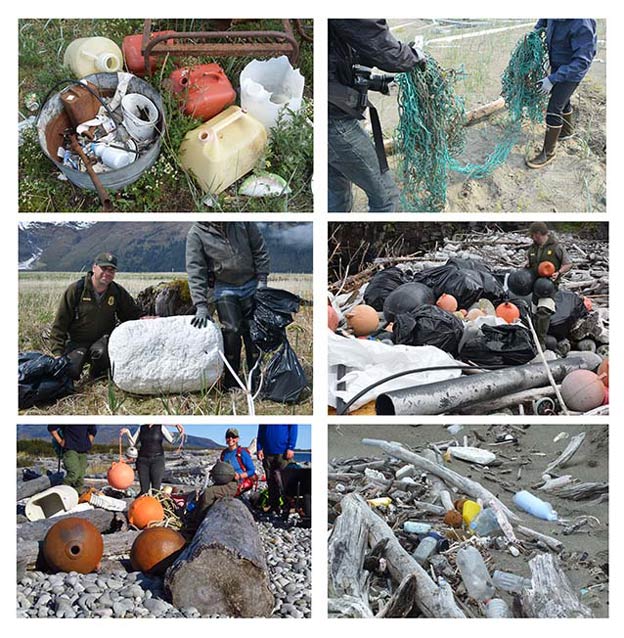
NPS Photos
Above: Examples of various marine debris types found throughout the five parks. Upper left: plastic gas cans and other debris in Cape Krusenstern National Monument. Upper right: Fishing nets in Bering Land Bridge National Preserve. Middle left: typical large foam piece found in Kenai Fjords National Park. Middle right: a large pile of debris collected from a single beach by workers in Kenai Fjords National Park. Lower left: foam and floats in Katmai National Park and Preserve. Lower right: plastic bottles typical of marine debris, on Bering Land Bridge National Preserve.
We found marine debris on all beaches surveyed. The team found hard plastic on all 28 beaches, foam at 27 beaches, rope and netting on 23 beaches, non-ferrous metal on 19 beaches, and rubber at 18 beaches. Only 14 of the 28 beaches that we visited had items designated in the “other” category. Hard plastic was the most common debris item making up 60 percent of the total weight of all the debris we collected.
We tallied the total weight and distance surveyed for each park (Figure 4). The total volume of debris that we collected in Kenai Fjords was 5,330 pounds (2,717.7 kilograms) with more than 60 percent plastic. We collected 5,316 pounds (2,411.4 kilograms) of debris from Wrangell-St. Elias and found more foam there than in any other park. In Katmai, we collected more debris than any other park with over 11,155 pounds (5,060.3 kilograms) of debris primarily comprised of hard plastics (not floats), rope, and netting (Figure 5). We collected the least debris in Bering Land Bridge: 497 pounds (225.5 kilograms). By proportion of beaches sampled, Bering Land Bridge had the highest amount of rope and netting, and it was the only park where we did not collect any rubber. Cape Krusenstern beaches had the second lowest amount with 1,464 pounds (664.1 kilograms) of debris and the lowest proportion of plastic compared to other parks. Unlike the Bering Land Bridge beaches (Figure 6), Cape Krusenstern beaches had the highest proportion of rubber (Figure 7).
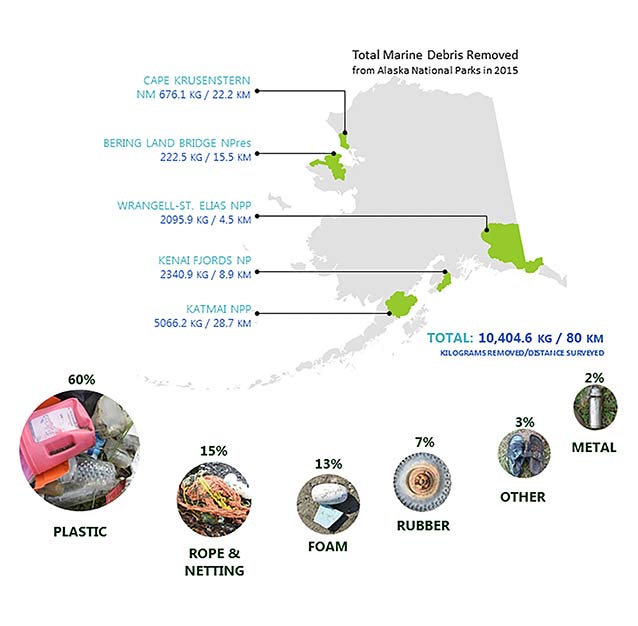
Our primary goal was debris removal and not quantification of debris found on beaches in park units. Furthermore, project beaches were not selected randomly with the goal of quantification, but were selected for management interest and logistical constraints. While it is difficult to compare across all of the parks because of these issues, the parks were located in two different regions of Alaska which appear to show different levels of debris overall: the Gulf of Alaska (Katmai, Kenai Fjords, and Wrangell-St. Elias) and the western Arctic (Bering Land Bridge and Cape Krusenstern). The Gulf of Alaska beaches had significantly more debris than the western Arctic beaches and the difference was likely driven by the much higher levels of plastic and foam in Gulf of Alaska parks (Figure 8). This difference may result from the physiographic constriction caused by the Bering Strait, the only connection of the Pacific to the Arctic Ocean, with oceanographic currents moving generally northward into the Arctic Ocean. The Bering Strait limits potential debris moving north from the Pacific Ocean to a 53-mile-wide gap, which affects how much debris reaches the western Arctic parks. Marine debris in the western Arctic parks seemed to be derived more from local terrestrial sources, such as coastal villages and numerous fishing camps, with light input from pan-Asian sources; previous surveys appeared to show that Cape Krusenstern debris sources derived more from local inputs while Bering Land Bridge’s debris sources were more regional. In contrast, the Gulf of Alaska parks are closer in proximity to the north Pacific Gyre, which harbors significant amounts of marine debris from many sources. Accumulation on Gulf of Alaska beaches occurs primarily during winter storms with strong onshore winds (Pallister and Gaudet 2011).
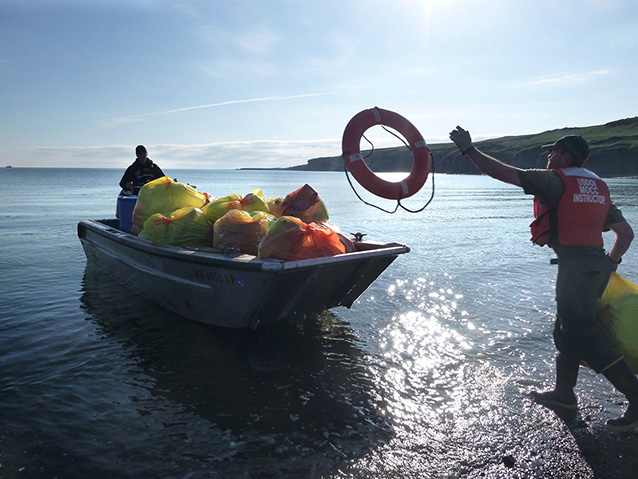
NPS Photo
These findings about marine debris are a snapshot in time, with results dependent on previous clean-up operations. Beaches with little or no clean-up history were expected to have a higher amount of debris than areas where recent clean-ups had occurred. Previous marine debris clean-up efforts in coastal Alaska were directly correlated with coastal accessibility. Between 2009 and 2014, Kenai Fjords and Resurrection Bay Conservation Alliance used boats to remove over 33,070 pounds (15 tons) of marine debris from 19 beaches (including the project beaches) within park boundaries; in 2014 alone, a half-ton of foam was removed from the project beaches during debris assessments to prevent foam disintegration. In June 2013, Katmai partnered with the Alaska SeaLife Center’s Gyre project on a marine debris cleanup of Hallo Bay and removed over 4,409 pounds (2 tons) of debris from 3.3 miles (5.4 kilometers) of beach. In 2005, a large-scale cleanup occurred for Sisualik Spit in Cape Krusenstern, a heavily used area by Kotzebue residents for seasonal hunting and fishing camps, and in 1999, a large-scale clean-up operation occurred in Bering Land Bridge to remove all 55-gallon drums from the outer coast of the Seward Peninsula. The Malaspina Forelands in Wrangell-St. Elias have not had a focused marine debris removal effort.
Partners Involved in the Beach Cleanups
This marine debris removal project involved an extensive number of partners, with National Park Foundation and National Park Service (NPS) Water Resources Division providing significant amounts of funding. The NPS provided personnel in all parks for the clean-up and logistics operations and the Alaska SeaLife Center managed data collection across the parks. Alaska Airlines donated 10 round-trip tickets for fieldwork across the five parks, and consolidated debris removal was coordinated with a Gulf of Alaska Keepers-State of Alaska marine debris removal project.
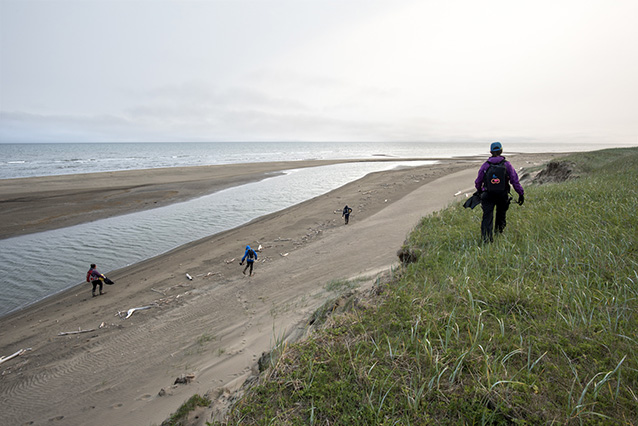
NPS Photo
Local park partners were extremely important in field clean-up efforts to collect and consolidate the marine debris. Wrangell-St. Elias worked closely with Yakutat Tlingit Tribe youth and interns from Youth Conservation Corps, Student Conservation Association, and Alaska Native Science and Engineering Program. Kenai Fjords worked with volunteers from Resurrection Bay Conservation Alliance. Port Graham Corporation, which owns various coastal lands within Kenai Fjords boundaries, was also a partner to ensure marine debris was removed from high-volume beaches. Katmai partnered with the Marine Vessels Ursus and Waters to help remove marine debris from Ninagiak Island. Bering Land Bridge and Cape Krusenstern partnered with the Boy Scouts of America, Alaska Teen Media Institute, Northwest Arctic Borough, and the Native Villages of Shishmaref, Wales, and Kotzebue.
Additional Partnering: Gulf of Alaska Keepers-State of Alaska Project
Along with the NPS debris removal operations, another large marine debris project coordinated by the Gulf of Alaska Keepers occurred simultaneously. The Gulf of Alaska Keepers conducted large-scale removal of marine debris across the Gulf of Alaska extending from Kodiak Island to British Columbia; it was originally funded by the Government of Japan through the State of Alaska Department of Environmental Conservation and the National Oceanic and Atmospheric Administration (NOAA). This project included transferring existing marine debris “super sack” caches onto a Waste Management, Inc. barge that moved across the Gulf of Alaska, starting from Kodiak Island and ending in Washington State. Super sacks are large mesh containers that hold approximately nine 55-gallon garbage bags full of debris to facilitate storage and transport using heavy equipment. Existing super sacks and had been amassed by Gulf of Alaska Keepers during previous years of marine debris clean-ups.
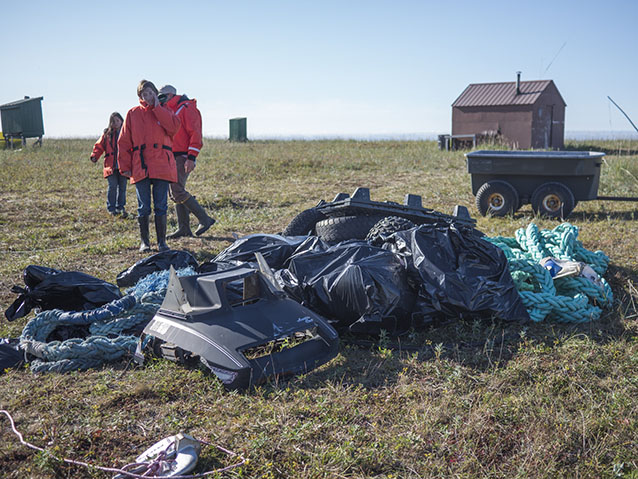
NPS Photo
The Gulf of Alaska Keepers-State of Alaska project greatly facilitated removal of marine debris in Katmai, Kenai Fjords, and Wrangell-St. Elias by not only accepting Katmai debris onto the barge at Kodiak Island, but also having the barge make slight route deviations to retrieve our marine debris super sacks in Kenai Fjords and Wrangell-St. Elias. This partnership was also good for the State of Alaska and the NPS; instead of transporting debris to be buried in an Alaska landfill, the debris was removed to an out-of-state facility capable of recycling much of the debris. The barge ultimately transported all of the debris to a Waste Management, Inc. facility in Seattle, Washington, where it was sorted for recycling. Anything not recyclable was taken to a landfill in eastern Oregon (Waste Management, pers. comm., January 2015).
Marine Debris Monitoring
Prior to 2015, four of the five parks (Kenai Fjords, Katmai, Bering Land Bridge, and Cape Krusenstern) had initiated NOAA marine debris monitoring protocols (Opfer et al. 2012; Lippiatt et al. 2013) to assess marine debris stocks and refreshment rates. In Alaska, the NOAA protocols were modified to document the large amount of marine debris that gets pushed inshore beyond the initial beach berm to a second barrier (such as a lagoon) by highly dynamic winter storms (P. Murphy and S. Lippiatt, pers. comm., February 2013).
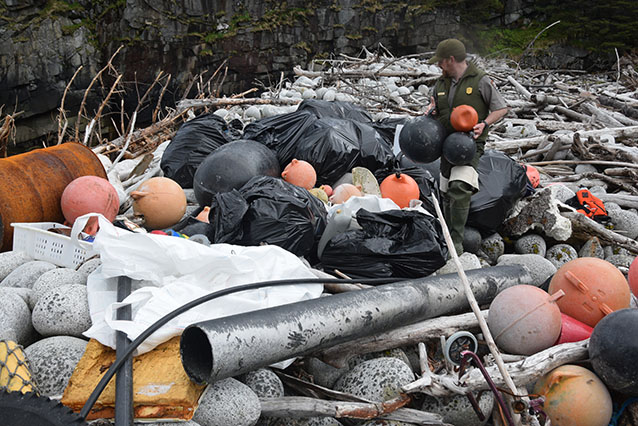
NPS Photo
Two types of NOAA marine debris monitoring can be done: accumulation surveys completely remove the marine debris from the site and document what returns, while standing stock surveys leave the marine debris in place and document the change in debris. Many of our remote beaches are only accessible by small airplane or boat (Figure 9), which do not have the capacity to remove debris from the site, so standing stock surveys are more frequently used in these remote beaches.
In 2015 in Kenai Fjords, NOAA accumulation surveys continued at Bulldog Cove, Northwestern Spit, and near Pedersen Lagoon; this is the third consecutive year for Bulldog and Northwestern and the second consecutive year for Pedersen. At Katmai, NOAA standing stock surveys were conducted in 2015 at Dakavak Bay, Hallo Bay, and Swikshak Bay for the fourth consecutive year. At Bering Land Bridge, paired NOAA accumulation and standing stock surveys were completed in 2013 and 2014, and additional work is planned for 2016. All of these data were uploaded to the NOAA database for their national analyses. This five-park project enabled Wrangell-St. Elias to initiate NOAA standing stock surveys on the Malaspina Forelands for the first time.
Outreach
Unless marine debris can be prevented from entering the environment, marine debris will continue to accumulate on park beaches. Thus, education and outreach are a clear part of the solution for marine debris prevention. Both Katmai and Kenai Fjords have been working closely with local schools to provide hands-on field activities related to marine debris. Katmai worked closely with Bristol Bay schools in August 2015; Kenai Fjords created a marine debris curriculum for high-school students and started working with a Seward High School class in August 2015 to conduct NOAA marine debris monitoring surveys at an accessible local beach outside of the park. Park education staff trained the students to use the NOAA protocols in the field so students themselves could conduct monthly monitoring and data entry into the national database throughout the school year. This curriculum will be presented as part of the Kenai Fjords distance learning curriculum and will also be shared with other parks with marine debris issues. In the Wrangell-St. Elias and the western Arctic parks (Bering Land Bridge and Cape Krusenstern), youth videographers gathered content during the field season and are working on video production. In addition, Bering Land Bridge and Cape Krusenstern partnered with the Center for Alaskan Coastal Studies to present marine debris classes and clean-ups in five schools in the Kotzebue Sound and Southern Chukchi Sea regions during the spring and fall of 2016. Wrangell-St. Elias will use the curriculum developed by Kenai Fjords and adapt it for classrooms in Yakutat.
Future Direction
All of the five parks will continue partnership efforts to remove marine debris and monitor changes in debris accumulation over time. While it is unlikely that this level of funding will occur again for these parks, each park will continue to work with its partners to get additional funding to continue both marine debris removal and outreach and education efforts.
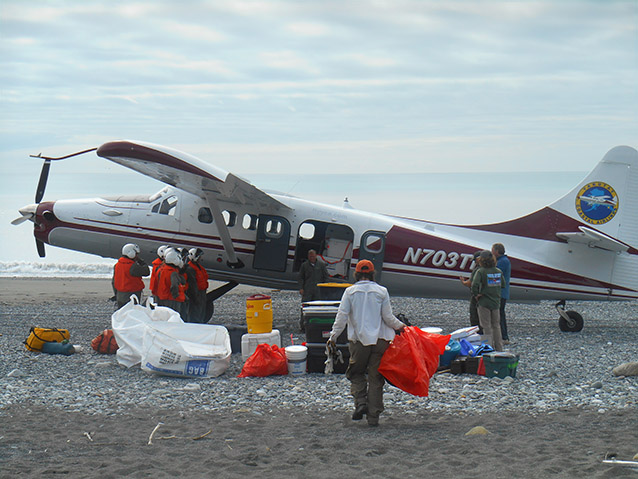
NPS Photo
For the Gulf of Alaska, discussions have begun about how to make a project like this occur on a more regular basis, whether the interval would be every several, five, or ten years. In the Arctic, a partnership has been forged with the Northwest Arctic Borough for ongoing work around known source areas near Bering Land Bridge and Cape Krusenstern.
Marine debris projects are tangible efforts that the public can relate to and where there are clear results after the beach is cleaned. While volunteer efforts can be challenging to organize for these remote locations with difficult logistics, often gathering a large group of volunteers, students, and interns can be an investment for future efforts and garnish additional support. For all the parks, we hope to continue to augment this marine debris removal and outreach project with our numerous partners.
Conclusion
While single events such as the 2011 Japanese tsunami can generate extensive marine debris, marine debris in Alaska is usually caused by more routine and common means such as lost shipping containers, derelict fishing gear, upstream littering, and other human activity; the debris is then transported by winter storm events, ocean currents, and wind (Howell et al. 2012). In populated remote areas of Alaska such as the western Arctic, solid waste containment is a challenge for local communities and many coastlines are littered with plastics. Because marine debris is a regularly occurring problem, it is critical to combat it at the source through education and outreach. As a two-pronged effort to combat this long-term problem, our project combined the removal of existing marine debris that affects wildlife, subsistence resources, and recreation experiences on remote park beaches with education and outreach efforts. Our goal was to help the public and next generation prevent marine debris from entering the environment.
Acknowledgments
This five-park project could not have occurred without major funding from the National Park Foundation. Alaska Airlines also supported the project by providing ten round-trip plane flights. The NPS Water Resource Division’s Ocean and Coastal Resources Branch funding also allowed the Gulf of Alaska parks to participate in the larger Gulf of Alaska Keepers-State of Alaska project. Thanks to Gulf of Alaska Keepers for working closely with the Gulf of Alaska national parks to directly connect with the larger State of Alaska/NOAA/Japan and Waste Management Inc. helicopter-barge efforts. Thanks to all the partners in this effort including Boy Scouts of America, Resurrection Bay Conservation Alliance, Port Graham Corporation, the M/V Serac crew, Yakutat Tlingit Tribe, M/V Ursus crew, M/V Waters crew, Alaska Teen Media Institute, Northwest Arctic Borough, and Native Villages of Shishmaref, Wales, and Kotzebue.
References
Arctic Council. 2009.
Arctic Marine Shipping Assessment 2009 Report. Second printing. Arctic Council.
Derraik, J. 2002.
The pollution of the marine environment by plastic debris: a review. Marine Pollution Bulletin 44: 842-852.
Government of Japan. 2012.
Estimated total amount of debris washed out by the Great East Japan Earthquake. Accessed 10/29/2015. http://www.kantei.go.jp/jp/singi/kaiyou/hyouryuu/pdf/souryou_eng.pdf
Howell, E., S. Bograd, C. Morishige, M. Seki, and J. Polovina. 2012.
On North Pacific circulation and associated marine debris concentration. Marine Pollution Bulletin 16–22. doi:10.1016/j.marpolbul.2011.04.034. 65
Lippiatt, S., S. Opfer, and C. Arthur. 2013.
Marine Debris Monitoring and Assessment. NOAA Technical Memorandum NOS-OR&R-46.
National Oceanic and Atmospheric Administration (NOAA). 2013.
Severe marine debris event report: Japan tsunami debris. Overview and update to Congress. August 2013.
Obbard, R., S. Sadri, Y. Wong, A. Khitun, I. Baker, and R. Thompson. 2014.
Global warming releases microplastic legacy frozen in Arctic Sea ice. Earth’s Future 2: 315–320, doi:10.1002/2014EF000240
Opfer, S., C. Arthur, and S. Lippiatt. 2012.
NOAA Marine Debris Shoreline Survey Field Guide. National Oceanic and Atmospheric Administration.
Pallister, C. and D. Gaudet. 2011.
Storm influenced marine debris movement into Prince William Sound, Alaska. Carswell, B., K. McElwee, and S. Morison (eds.). Technical Proceedings of the Fifth International Marine Debris Conference. March 20–25, 2011. NOAA Technical Memorandum NOS OR&R-38.
Rochman, C., E. Hoh, T. Kurobe, and S. Teh. 2013.
Ingested plastic transfers hazardous chemicals to fish and induces hepatic stress. Scientific Reports 3:3263 | DOI: 10.1038/srep03263
Ryan, P., C. Moore, J.A. van Franeker, and C. Moloney, C. 2009.
Monitoring the abundance of plastic debris in the marine environment. Philosophical Transactions of the Royal Society B. 364, 1999-2012.
U.S. Environmental Protection Agency. 2011.
Marine Debris in the North Pacific: A Summary of Existing Information and Identification of Data Gaps. White paper. November 2011.
Part of a series of articles titled Alaska Park Science - Volume 15 Issue 1: Coastal Research Science in Alaska's National Parks.
Last updated: November 21, 2016
